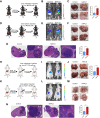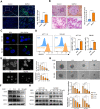Non-alcoholic fatty liver disease promotes liver metastasis of colorectal cancer via fatty acid synthase dependent EGFR palmitoylation
- PMID: 38263401
- PMCID: PMC10805926
- DOI: 10.1038/s41420-023-01770-x
Non-alcoholic fatty liver disease promotes liver metastasis of colorectal cancer via fatty acid synthase dependent EGFR palmitoylation
Abstract
Liver metastasis is the major reason for most of colorectal cancer (CRC) related deaths. Accumulating evidence indicates that CRC patients with non-alcoholic fatty liver disease (NAFLD) are at a greater risk of developing liver metastasis. With the growing prevalence of NAFLD, a better understanding of the molecular mechanism in NAFLD-driven CRC liver metastasis is needed. In this study, we demonstrated that NAFLD facilitated CRC liver metastasis as a metabolic disorder and promoted the stemness of metastatic CRC cells for their colonization and outgrowth in hepatic niches. Metabolically, the lipid-rich microenvironment in NAFLD activated de novo palmitate biosynthesis in metastatic CRC cells via upregulating fatty acid synthase (FASN). Moreover, increased intracellular palmitate bioavailability promoted EGFR palmitoylation to enhance its protein stability and plasma membrane localization. Furthermore, we demonstrated that the FDA-approved FASN inhibitor orlistat could reduce NAFLD-activated endogenous palmitate production, thus inhibiting palmitoylation of EGFR to suppress CRC cell stemness and restrict liver metastasis in synergy with conventional chemotherapy. These findings reveal that the NAFLD metabolic microenvironment boosts endogenous palmitate biosynthesis in metastatic CRC cells and promotes cell stemness via EGFR palmitoylation, and FASN inhibitor orlistat could be a candidate adjuvant drug to suppress liver metastasis in CRC patients with NAFLD.
© 2024. The Author(s).
Conflict of interest statement
The authors declare no competing interests.
Figures








Similar articles
-
The progress of non-alcoholic fatty liver disease as the risk of liver metastasis in colorectal cancer.Expert Rev Gastroenterol Hepatol. 2019 Dec;13(12):1169-1180. doi: 10.1080/17474124.2019.1697231. Epub 2019 Nov 29. Expert Rev Gastroenterol Hepatol. 2019. PMID: 31774328 Review.
-
Enhanced De Novo Lipid Synthesis Mediated by FASN Induces Chemoresistance in Colorectal Cancer.Cancers (Basel). 2023 Jan 17;15(3):562. doi: 10.3390/cancers15030562. Cancers (Basel). 2023. PMID: 36765520 Free PMC article.
-
In Vivo Effectiveness of Orlistat in the Suppression of Human Colorectal Cancer Cell Proliferation.Anticancer Res. 2019 Jul;39(7):3815-3822. doi: 10.21873/anticanres.13531. Anticancer Res. 2019. PMID: 31262909
-
Inhibition of de novo Palmitate Synthesis by Fatty Acid Synthase Induces Apoptosis in Tumor Cells by Remodeling Cell Membranes, Inhibiting Signaling Pathways, and Reprogramming Gene Expression.EBioMedicine. 2015 Jul 2;2(8):808-24. doi: 10.1016/j.ebiom.2015.06.020. eCollection 2015 Aug. EBioMedicine. 2015. PMID: 26425687 Free PMC article.
-
Non-alcoholic fatty liver disease and colorectal cancer.Postgrad Med J. 2017 Mar;93(1097):153-158. doi: 10.1136/postgradmedj-2016-134383. Epub 2016 Nov 16. Postgrad Med J. 2017. PMID: 27852946 Review.
Cited by
-
Protein S-palmitoylation modification: implications in tumor and tumor immune microenvironment.Front Immunol. 2024 Feb 13;15:1337478. doi: 10.3389/fimmu.2024.1337478. eCollection 2024. Front Immunol. 2024. PMID: 38415253 Free PMC article. Review.
-
An interpretable machine learning model for predicting early liver metastasis after pancreatic cancer surgery.BMC Cancer. 2025 Jul 1;25(1):1117. doi: 10.1186/s12885-025-14503-3. BMC Cancer. 2025. PMID: 40598044 Free PMC article.
-
Fatty acid metabolism-related enzymes in colorectal cancer metastasis: from biological function to molecular mechanism.Cell Death Discov. 2024 Aug 5;10(1):350. doi: 10.1038/s41420-024-02126-9. Cell Death Discov. 2024. PMID: 39103344 Free PMC article. Review.
-
S-palmitoylation: a novel insight in the development and immunotherapy of oral squamous cell carcinoma.J Cancer. 2025 Jun 12;16(9):2787-2799. doi: 10.7150/jca.110721. eCollection 2025. J Cancer. 2025. PMID: 40657375 Free PMC article. Review.
-
Obesity-Associated Colorectal Cancer.Int J Mol Sci. 2024 Aug 14;25(16):8836. doi: 10.3390/ijms25168836. Int J Mol Sci. 2024. PMID: 39201522 Free PMC article. Review.
References
Grants and funding
LinkOut - more resources
Full Text Sources
Research Materials
Miscellaneous

